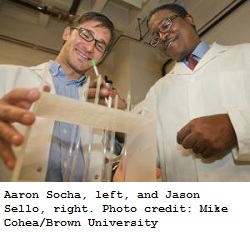 Researchers at Brown University have found a more streamlined and greener way to turn waste vegetable oil into biodiesel.
Researchers at Brown University have found a more streamlined and greener way to turn waste vegetable oil into biodiesel.
This school press release says Brown University chemist Jason Sello and postdoctoral researcher Aaron Socha have eliminated the corrosive chemicals usuallu used in the reactions… a process that is six times faster than previous methods, using less energy:
“We wanted to develop an environmentally benign and technically simple way to convert waste vegetable oil into biodiesel,” said Sello, assistant professor of chemistry. “The production of energy at the expense of the environment is untenable and should be avoided at all costs.”
Waste vegetable oil is made up of triacylglycerols, free fatty acids, and water. The conventional way to convert waste vegetable oil into biodiesel requires two separate reactions. The first reaction turns the free fatty acids into biodiesel, but that conversion requires sulfuric acid. The second reaction converts the triacylglycerols into biodiesel, but that conversion requires sodium hydroxide or potassium hydroxide. Sodium hydroxide/potassium hydroxide and sulfuric acid are not compatible with each other, so the reactions must be carried out in separate vessels. That makes the process less efficient.
To find a better way, Sello and Socha went looking for catalysts that would be cheap, chemically stable and of limited toxicity. They settled on the metals bismuth triflate and scandium triflate, commonly used as catalysts in preparative organic chemistry. In addition, they performed the reactions using a microwave reactor instead of a conventional thermal heater. What they found was the new catalysts converted waste vegetable oil into biodiesel in about 20 minutes in the microwave reactor, whereas current reactions without catalysts using a conventional heater take two hours. While their microwave method needs a higher temperature to pull off the biodiesel conversion — 150 degrees Celsius versus 60 degrees Celsius under current methods — it uses less energy overall because the reaction time is much shorter.
The chemists also were able to perform the conversion in one reaction vessel, since the catalysts can promote both the reaction that converts free fatty acids into biodiesel and the reaction in which triacylgycerols are converted to biodiesel.
The catalysts in the conversion can be reused up to five times. Now the challenge is to do the process on an industrial scale.

